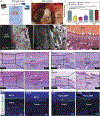Engineering a highly elastic human protein-based sealant for surgical applications
- PMID: 28978753
- PMCID: PMC11186511
- DOI: 10.1126/scitranslmed.aai7466
Engineering a highly elastic human protein-based sealant for surgical applications
Erratum in
-
Erratum for the Research Article: "Engineering a highly elastic human protein-based sealant for surgical applications" by N. Annabi, Y.-N. Zhang, A. Assmann, E. S. Sani, G. Cheng, A. D. Lassaletta, A. Vegh, B. Dehghani, G. U. Ruiz-Esparza, X. Wang, S. Gangadharan, A. S. Weiss, A. Khademhosseini.Sci Transl Med. 2018 Dec 5;10(470):eaaw0535. doi: 10.1126/scitranslmed.aaw0535. Sci Transl Med. 2018. PMID: 30518609 No abstract available.
-
Erratum for the Research Article "Engineering a highly elastic human protein-based sealant for surgical applications" by N. Annabi et al.Sci Transl Med. 2025 Jul 30;17(809):eaea4285. doi: 10.1126/scitranslmed.aea4285. Epub 2025 Jul 30. Sci Transl Med. 2025. PMID: 40737435 No abstract available.
Abstract
Surgical sealants have been used for sealing or reconnecting ruptured tissues but often have low adhesion, inappropriate mechanical strength, cytotoxicity concerns, and poor performance in biological environments. To address these challenges, we engineered a biocompatible and highly elastic hydrogel sealant with tunable adhesion properties by photocrosslinking the recombinant human protein tropoelastin. The subcutaneous implantation of the methacryloyl-substituted tropoelastin (MeTro) sealant in rodents demonstrated low toxicity and controlled degradation. All animals survived surgical procedures with adequate blood circulation by using MeTro in an incisional model of artery sealing in rats, and animals showed normal breathing and lung function in a model of surgically induced rat lung leakage. In vivo experiments in a porcine model demonstrated complete sealing of severely leaking lung tissue in the absence of sutures or staples, with no clinical or sonographic signs of pneumothorax during 14 days of follow-up. The engineered MeTro sealant has high potential for clinical applications because of superior adhesion and mechanical properties compared to commercially available sealants, as well as opportunity for further optimization of the degradation rate to fit desired surgical applications on different tissues.
Copyright © 2017 The Authors, some rights reserved; exclusive licensee American Association for the Advancement of Science. No claim to original U.S. Government Works.
Conflict of interest statement
Figures






References
-
- Burdick JA, Murphy WL, Moving from static to dynamic complexity in hydrogel design. Nat. Commun. 3, 1269 (2012). - PubMed
MeSH terms
Substances
Grants and funding
LinkOut - more resources
Full Text Sources
Other Literature Sources
Medical

